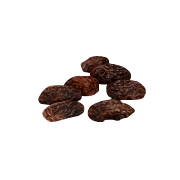GlenfiddichSingle Malt Scotch Whisky
The iconic triangular green bottle was introduced in 1957 and can now be found in just about every licensed establishment (and probably most of the unlicensed ones as well) in the world.
From the website
Set in the heart of the Highlands, Glenfiddich (meaning ‘Valley of the Deer’ in Gaelic) is a place of breathtaking beauty. The vibrant colours of an artist’s palate fill the surrounding hills and forests, while haunting castle ruins and a bubbling natural spring add to the romance.
Glenfiddich is little changed since 1886, when William Grant and his nine children rolled up their sleeves to build the Distillery with their bare hands. These same silent warehouses and steamy mash rooms produce the world’s favourite single malt Scotch whisky today.
At The Glenfiddich Distillery, time and experience are the heart of the operation. Accumulated and passed down through five generations, the rich whisky making experience of our craftsmen ensures each variant in the Glenfiddich single malt Scotch whisky range matures exquisitely well - balancing rich complexity with Glenfiddich’s unmistakable character.
Remaining independent and family-owned gives the maker’s of Glenfiddich Scotch whisky the privilege of a long term perspective. As such we have retained many expensive and time-consuming techniques to ensure the consistent and exceptional quality of our whiskies.
At The Glenfiddich Distillery we use the finest malt from specialist maltsters, produced to our own specification. Ripe barley is steeped in water for two days, which triggers germination. The barley is then left to germinate for four to five days, which starts the conversion of natural starch into sugar. The resulting 'green malt' is dried over fire, and delivered to the Distillery as malted barley.
INSIDE THE MASH HOUSE
Two of Glenfiddich single malt Scotch whisky’s essential ingredients - malted barley and soft clear water - are brought together in the mash house. The malted barley is ground into 'grist' - a coarse flour that is mixed with heated pure Robbie Dhu spring water from the nearby Conval Hills and then poured into giant 'mash tuns'. Here a slowly rotating set of mash knives lift and sift the mash to ensure good sugar drainage. In the mash tuns, the natural bubbling chemistry and clouds of steam rise, filling the air with a pleasantly pungent aroma. The hot water completes the conversion of starch to sugar, which dissolves into the water, producing a sweet liquid called 'wort', some six hours later. The wort is drained, cooled and made ready for fermentation. The 'draff' - the left over barley from the process - is sold to farmers and fed to their cattle.
FERMENTATION IN THE WASHBACKS
Yeast is added to the wort as it is pumped from the cooler into the traditional wooden fermentation vessels, the 'washbacks'. Our handmade washbacks are made of Douglas fir rather than the stainless steel that many other distilleries use. This traditional method of production is kept so as to not alter the flavour of the whisky. These washbacks are a towering 17 feet high (5 metres), and are filled to within 3 feet (1m) from the top. As fermentation raises the temperature from around 19°C to about 33°C, the resulting carbon dioxide gas creates a massive, hot frothing head to the wort that foams up the remaining 3 feet (1m) to the top of the washback and has to be kept down with mechanical beaters.
After around 64 hours of fermentation, the furious bubbling subsides, leaving a brown liquid of 8-9% ABV, similar to a strong beer - the 'wash'.
ALCHEMY AND DOUBLE DISTILLATION IN THE STILL HOUSE
The heart of the distillation process lies in the still house, where the wash is distilled in copper pot stills that exactly match the shape and size of the original stills bought over a century ago by William Grant. Every bump and dent is reproduced - we're not taking any chances with our unique flavour.
The stills continue to be heated by 'direct firing' (applying a naked flame directly under the base). The wash in the stills is gradually heated until the alcohol turns to vapour. The vapour rises through the narrowing neck of the still and is guided downwards and through a water-cooled condenser. This condenses the vapour into an intermediate liquid, known as 'low wines'. The low wines, containing about 21% alcohol, are heated in remarkably small 'spirit stills', smaller versions of the wash still.
The vaporised alcohol is drawn off and condensed as before, and then trickles down into the imposing, gleaming brass and glass 'spirit safe', where the flow of spirit can be controlled. This liquid is now legally a bonded, taxable spirit, so it is kept under lock and key. The stillman runs the delicate operation of monitoring this distillation - any mistake can ruin the whisky's flavour. Only the fine middle cut, or 'heart' of the distillation is retained for maturation. The stillman catches it at the flick of a tap - a new batch of Glenfiddich is born.
Did you know?
- Glenfiddich was the first single malt to be marketed outside Scotland
- The distillery was one of only six to continue production throughout prohibition
Character and Style of Glenfiddich
-
 Pear
Pear
-
 Grass
Grass
-
 Sultana
Sultana
-
 Hay
Hay
-
 Apple
Apple
COOPERING & MATURATION HAMMER AND TONGS - INSIDE THE COOPERAGE
The new spirit is reduced to around 63% alcohol with natural spring water from our Robbie Dhu springs and then filled into hand-built oak casks, prepared and maintained at the Distillery's own cooperage. All casks filled at The Glenfiddich Distillery are first checked by one of our qualified coopers, a practice unique to the making of Glenfiddich whiskies.
The coopers, who apprentice for approximately five years (as much as a doctor!), work with incredible speed and agility to assemble, repair or reconstruct around 25 casks each every day. We use only the very best casks made from the very best wood, such as sherry butts from Spain and bourbon barrels from America that have had only one filling of sherry or bourbon whisky.
By using these ‘second-hand’, high quality casks, we achieve a high quality spirit. Mellowed by previous use, the oak helps mature the Scotch whisky, allowing it to breathe, soften, assume subtle flavours and absorb a pale golden colour. Sometimes we char the inside of the cask with a blast of fire to open the grain of the wood, allowing the Scotch whisky to interact more easily with it.
We know that the quality of our barrels is vital, as this is where the magic happens. Even when pressure-testing our sherry barrels, we use sherry instead of water so that their integrity is not compromised.
MATURATION - WHERE THE MAGIC HAPPENS
Our distillery is the only single malt whisky still using wooden marrying tuns (2,000 litre plus vats). We also marry our whiskies for an unusually long period of time…
These wooden casks are then stored on-site in our traditional warehouses, and the spirit is left to mature. The atmospherically dark, damp interior of the warehouse and the temperature, humidity and climate of this environment provide optimum conditions for maturing the best quality Scotch whiskies. It is here that the Glenfiddich spirit acquires its distinctive, well-balanced character.
As a cask ages and develops, it breathes in the pure Highland air through the porous oak. Consequently, alcohol compounds evaporate off the whisky, through the wood, back into the air - roughly 2% from each cask per year. It is estimated that throughout Scotland, approximately 16 million litres of Scotch whisky is lost this way each year. This lost spirit is known as “the Angels' Share”.
The perfect match - marrying the whiskyAs no two distillations ever taste exactly the same, before bottling we perform one further practice not used by many distilleries today: marrying. To maintain a consistent quality of flavour, aroma and palate, we combine or “marry” various casks, post-maturation, in a marrying tun - a large oak barrel which holds approximately 30 casks of whisky.
Glenfiddich is the only single malt which is still made using these oak Marrying Tuns. Our whiskies are married for up to nine months so that the different elements become unified into the special and distinctive taste of Glenfiddich single malt Scotch whisky. It is a dying art in the whisky world but for the maker’s of Glenfiddich the time spent marrying is important because it ensures all the flavours of the whisky are in harmony and makes the product even more unique.
Glenfiddich comes of age - the bottling hall
When the spirit has matured to perfection, the casks are emptied and the whisky is 'cut' with pure Robbie Dhu spring water. This reduces the alcohol by volume once more to around 40% ABV.
Nearly all of the Glenfiddich single malt Scotch whisky range is then bottled on site at The Glenfiddich Distillery, other than 12 Year Old (which is made bottle ready, ensuring all quality-control parameters are kept on site). Glenfiddich is the only Highland single malt distilled, matured and even bottled at its own distillery, using a single source of spring water throughout the process.
Filter
Price Range
Bottling Status
Age
Vintage
Cask Type
Bottler
Series
Strength
Size
Single Cask
Limited Edition
Flavour Profile
Colouring

Glenfiddich 18 Year Old
$94.65
($135.21 per litre)

Save
$5.57Glenfiddich 15 Year Old SoleraSmall Bottle
$13.97
($6.98 per 10cl)

Glenfiddich 12 Year Old
$39.85
($56.94 per litre)

Glenfiddich Project XXExperimental Series
$54.74
($78.20 per litre)

Glenfiddich 23 Year OldGrand Cru
$258.87
($369.81 per litre)

Glenfiddich Fire and CaneExperimental Series #04
$48.48
($69.26 per litre)

Glenfiddich 21 Year OldGran Reserva Rum Cask Finish
$186.60
($266.57 per litre)

Glenfiddich 29 Year OldGrand Yozakura Awamori Finish
$1,671.84
($2,388.35 per litre)

Glenfiddich 15 Year Old Solera
$57.11
($81.59 per litre)

Glenfiddich 26 Year OldGrande Couronne Cognac Finish
$528.52
($755.03 per litre)

Glenfiddich Orchard ExperimentExperimental Series #05
$51.50
($73.58 per litre)

Glenfiddich Malt Master's EditionSherry Cask Finish
$59.27
($84.67 per litre)

Glenfiddich 30 Year OldSuspended Time Re-imagined Time Series
$1,051.64
($1,502.35 per litre)

Glenfiddich Pure MaltSpecial Old Reserve Clan Drummond Bot.1980s
$161.79
($215.72 per litre)

Glenfiddich Pure Malt Special Old ReserveBot.1980s
$161.79
($215.72 per litre)

Glenfiddich 21 Year Old Winter StormBatch Two
$485.37
($693.39 per litre)

Glenfiddich Snow Phoenix
$916.82
($1,309.74 per litre)

Glenfiddich Perpetual Collection Vat 2
$107.81

Glenfiddich Perpetual Collection Vat 1
$94.86

Glenfiddich Excellence18 Year Old
$377.51
($539.30 per litre)

Glenfiddich 1976 Willow ParkCask 16389
$2,426.87
($3,466.96 per litre)

Glenfiddich 21 Year OldHavana Reserve
$430.37
($614.81 per litre)

Glenfiddich 10 Year OldStill Master's Crock 101 Proof
$269.65
($359.54 per litre)

Glenfiddich 1972Cask #16034
$2,966.17
($4,237.39 per litre)



 Glenfiddich
Glenfiddich